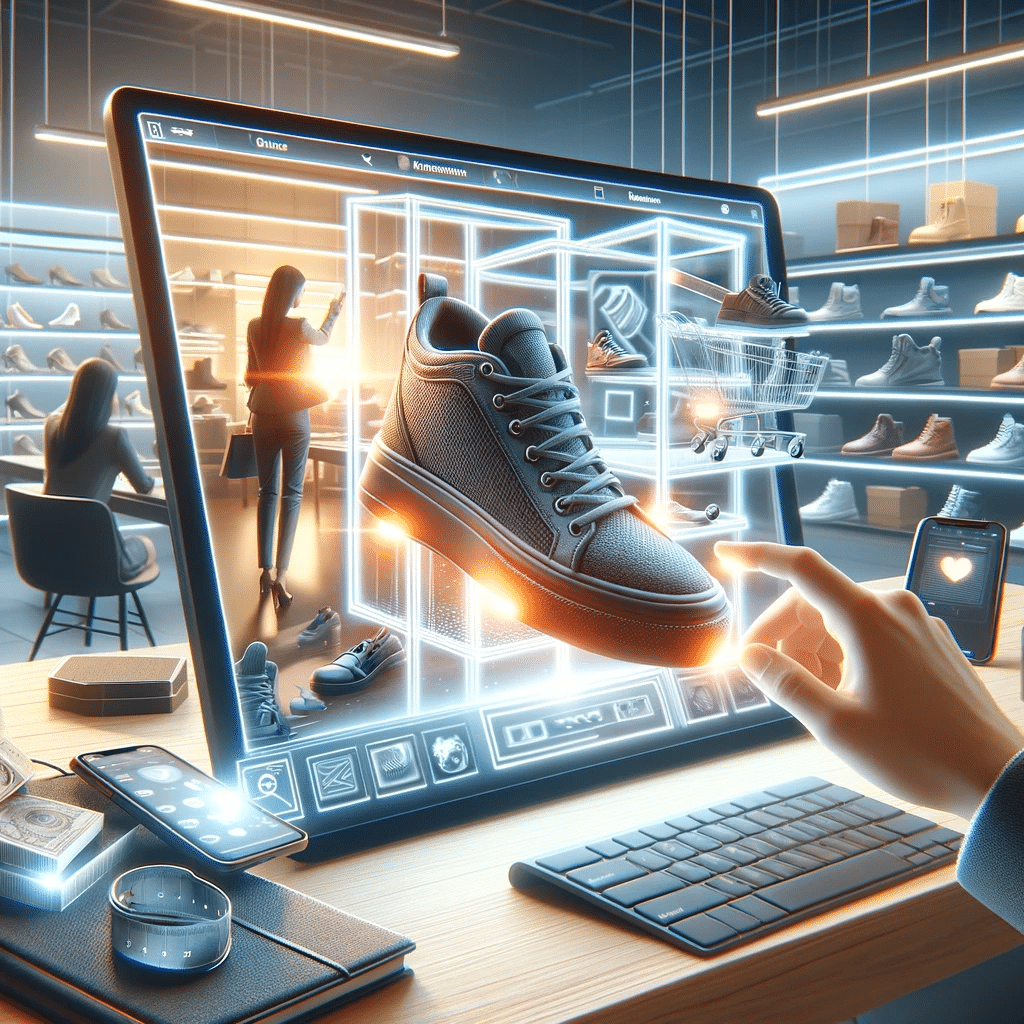The power of 3D product visualization: Product visualization in transition
In today’s digital world, product visualization plays a critical role in capturing consumer attention and driving sales. With advances in technology, 3D product visualization has evolved into a powerful tool that is changing the way products are presented and experienced. By bringing products to life in a virtual environment, 3D product visualization offers a level of realism and interactivity that traditional 2D images simply cannot match.
Understanding 3D product visualization

The basics of 3D product visualization
At its core, 3D product visualization is the process of creating three-dimensional representations of products using computer-generated graphics. By modeling products in a virtual environment, designers and marketers can present their features, materials and dimensions in a visually appealing and realistic way. In this way, customers can not only understand the product better, but also explore it from different angles and perspectives.
When it comes to 3D product visualization, the possibilities are endless. Designers can create lifelike renderings of products, complete with intricate details and textures. You can simulate different lighting conditions to show how the product would look in different environments. You can even animate the product to demonstrate its functionality and use.
In addition, 3D product visualization offers a degree of flexibility that conventional photography cannot match. With a virtual model, designers can easily make changes or adjustments to the product without the need for costly reshoots. You can experiment with different materials, colors and configurations, allowing for quick iterations and customizations.
Main features of 3D product visualization
One of the most important features of 3D product visualization is the ability to provide accurate and detailed representations of products. This level of precision is particularly important for complex products that are difficult to capture with conventional photos. In 3D modeling, every curve, every edge and every surface of the product can be meticulously worked out to ensure a realistic representation.
Another advantage of 3D product visualization is its versatility. Designers can create virtual environments and scenes to present the product in context. For example, a furniture designer can place their product in a beautifully furnished living room so that customers can imagine how it would fit into their own space. This contextualization lends depth and realism to the visualization and makes it more appealing and comprehensible to the customer.
In addition, 3D product visualization enables individual design and personalization. Customers can interact with the virtual model and try out different options, e.g. change the color, material or configuration of the product. This level of interactivity enables customers to make informed decisions and ensures that they receive a product that meets their specific needs and preferences.
In summary, 3D product visualization is a powerful tool that allows designers and marketers to create visually stunning and highly customizable representations of products. By harnessing the power of computer-generated graphics, they can give their customers a comprehensive picture of the product’s properties, materials and dimensions. Whether for marketing purposes or product development, 3D product visualization offers endless possibilities for presenting and exploring products in a virtual environment.
The role of 3D product visualization in product visualization

Improved product design with 3D product visualization
3D product visualization has revolutionized the product design process. Designers can now create virtual prototypes and thus identify and correct any design errors or improvements before the product goes into production. The ability to visualize products in a virtual environment also facilitates collaboration between designers, engineers and other stakeholders, leading to better design results and more efficient product development.
With 3D product visualization, designers can manipulate the virtual prototypes and try out different design options and variants. You can easily adjust dimensions, materials and colors to see how these changes affect the overall product. This level of flexibility allows for more creativity and innovation in the design process and results in products that are not only visually appealing, but also functional and user-friendly.
In addition to its influence on the design phase, 3D product visualization also plays a decisive role in product testing and validation. By simulating real-life conditions and interactions, designers can evaluate the performance and functionality of their products before investing in expensive physical prototypes. This not only saves time and resources, but also ensures that the end product meets the desired specifications and quality standards.
Rationalization of the production process
3D product visualization not only improves product design, but also has a significant impact on the production process. Since physical prototypes are no longer required, manufacturers can save time and resources. In addition, the virtual representation of products can be used for demonstrations, customer presentations and marketing purposes, further reducing the need for physical samples.
With 3D product visualization, manufacturers can visualize the entire production process, from assembly to packaging, in a virtual environment. This enables them to identify potential bottlenecks, optimize workflows and ensure efficient use of resources. By simulating the production process, manufacturers can also anticipate and address potential problems or challenges, minimizing the risk of delays or costly mistakes.
In addition, 3D product visualization enables manufacturers to create realistic and true-to-life product visualizations for marketing and advertising purposes. These virtual representations can be used in promotional materials, websites and online catalogs, allowing potential customers to explore and interact with the products before making a purchase decision. This not only improves the customer’s shopping experience, but also increases the chances of conversion and sales.
In summary, it can be said that 3D product visualization has changed the product design and production process. It enables designers to create virtual prototypes, collaborate effectively and make informed design decisions. It also allows manufacturers to streamline their production processes, reduce costs and create compelling product visualizations for marketing purposes. As technology advances, the role of 3D product visualization in product visualization will only grow stronger, driving innovation and efficiency in various industries.
The influence of 3D product visualization on marketing and sales

Create captivating product presentations
In the digital age, it is more difficult than ever to attract the attention of customers. With the rise of online shopping and the plethora of options available, marketers are constantly looking for innovative ways to stand out from the competition. One of these methods is the use of 3D product visualization, which can be used to create visually captivating product presentations.
By using 3D technology, marketers can present products in a realistic and interactive way. This allows customers to engage with the content on a deeper level and is more likely to make a purchase decision. The ability to zoom, rotate and explore product features provides a rich and immersive experience that leaves a lasting impression on potential buyers.
Imagine a customer looking for a new pair of shoes in an online store. With conventional product images, he can only view the shoes from a few different angles. However, with 3D product visualization, they can virtually hold the shoes in their hands, examine every detail and even see how they look from different angles. This level of interactivity not only captures their attention, but also helps them to make an informed purchasing decision.
Promotion of e-commerce with 3D product visualization
E-commerce has revolutionized retail, offering convenience and accessibility to customers around the world. However, a major disadvantage of online shopping is the lack of opportunity to physically interact with the products. This lack of tactile experience often leads to uncertainty and hesitation when buying.
3D product visualization bridges this gap by providing a virtual showroom. Customers can now explore products in detail, visualize them in different environments and even try out different combinations or configurations. For example, a customer looking to buy furniture can virtually place the 3D model of a sofa in their living room to see how it fits in with the existing furnishings. This level of individualization and personalization improves the online shopping experience and makes it even more appealing and interactive.
In addition, 3D product visualization helps to reduce returns and increase customer satisfaction. By presenting the product in more detail, customers can better understand what they are buying. This reduces the likelihood of disappointment on delivery and minimizes the need for returns or exchanges. This means that both customers and retailers benefit from a smoother and more efficient purchasing process.
In summary, it can be said that 3D product visualization has a significant impact on marketing and sales. By creating appealing product presentations and improving the e-commerce experience, it helps marketers to attract customers’ attention and increase sales. As technology continues to advance, we can expect to see even more innovative applications of 3D visualization in the future.
Future trends in 3D product visualization

Advances in 3D rendering technologies
As technology evolves, so does 3D product visualization. Advances in rendering technologies have led to more realistic and lifelike visualizations. High-quality textures, lifelike lighting effects and photorealistic images are becoming the norm. With the increasing performance of hardware and software, the possibilities for creating impressive visualizations are practically limitless.
The growing importance of virtual reality in product visualization
Virtual reality (VR) is another trend that will revolutionize the way products are visualized and experienced. As VR headsets become more accessible and affordable, consumers can now immerse themselves in a virtual world and interact with products as if they were physically present. VR offers a highly engaging and immersive experience that allows customers to assess the size, scope and functionality of products in a way that was previously impossible. The use of VR in product visualization is expected to increase rapidly in the coming years and change the way we shop and make purchasing decisions.
Overcoming challenges in the implementation of 3D product visualization
Overcoming technical hurdles
Implementing 3D product visualization can present technical challenges, especially for companies transitioning from traditional visual techniques. These challenges include the hardware and software requirements as well as the need for qualified personnel to operate and maintain the systems. However, with the right planning and investment, these hurdles can be overcome and the benefits of 3D product visualization can be exploited.
Navigating the learning curve for 3D product visualization
The introduction of a new technology is always associated with a learning curve. In the case of 3D product visualization, training employees to use the tools and software effectively is essential. This may include providing workshops, resources and ongoing support to ensure a smooth transition. Investing in training and empowering employees to use the possibilities of 3D product visualization is crucial for a successful implementation.
In summary, it can be said that 3D product visualization is fundamentally changing product visualization. Their ability to create highly realistic and interactive representations of products is revolutionizing the way we design, market and sell products. From improving product design and streamlining the production process to captivating customers and shaping the future of e-commerce, 3D product visualization has the power to change the way we experience and interact with products. With the continuous advancements in technology, the potential of 3D product visualization is limitless, and its influence on various industries will only grow.
For a prime example and information on the use of 3D technologies in the industry, visit marconomy.de.
Find out more about klar.land’s machine demo at Interzum here.

Leave a Reply